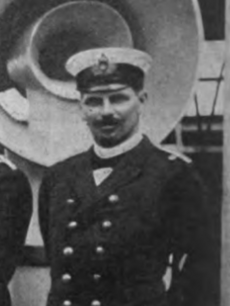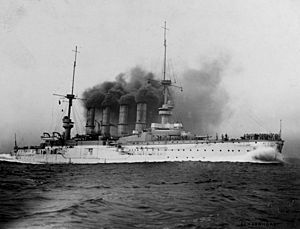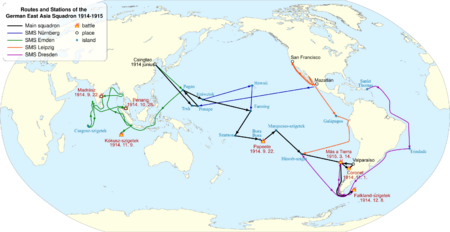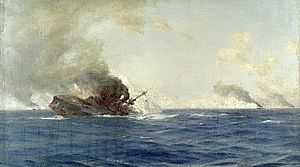Maximilian von Spee facts for kids
Quick facts for kids
Reichsgraf
Maximilian von Spee
|
|
|---|---|
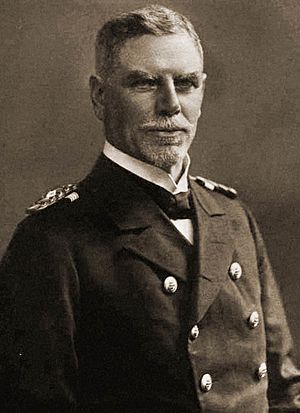
Maximilian von Spee
|
|
| Born | 22 June 1861 Copenhagen, Denmark |
| Died | 8 December 1914 (aged 53) SMS Scharnhorst, South Atlantic, off the Falkland Islands |
| Allegiance | |
| Service/ |
|
| Years of service | 1878–1914 |
| Rank | Vizeadmiral (Vice Admiral) |
| Commands held | SMS Hela SMS Pelikan SMS Wittelsbach East Asia Squadron |
| Battles/wars |
|
Maximilian von Spee (born 22 June 1861 – died 8 December 1914) was a German naval officer. He led a group of warships called the East Asia Squadron during World War I. Spee joined the navy in 1878 and served in many different places. He was in German West Africa in the 1880s and the East Africa Squadron in the late 1890s. He also commanded several ships in the main German fleet.
In the late 1880s, he married Margareta and had three children: Heinrich, Otto, and Huberta. By 1912, he was back leading the East Asia Squadron. He was promoted to Vice Admiral the next year.
When World War I began in July 1914, Spee sailed his squadron across the Pacific Ocean. On 1 November, he defeated a British fleet in the Battle of Coronel, sinking two of their ships. A month later, Spee decided to attack a British naval base in the Falkland Islands. However, a much stronger British fleet surprised him. In the Battle of the Falkland Islands, the British destroyed the East Asia Squadron. Spee and his two sons, who were serving on his ships, were all killed. About 2,200 other men also died. Spee became a hero in Germany, and several ships were named after him.
Contents
Maximilian von Spee was born in Copenhagen, Denmark, on 22 June 1861. He grew up in Germany, where his family had a large estate. He joined the German Imperial Navy (Kaiserliche Marine) in 1878. His first duties were at the main German naval base in Kiel.
He became an officer with the rank of Lieutenant (Leutnant zur See). He was sent to western Africa on the gunboat SMS Möwe. During this trip, Germany signed agreements with local leaders in Togo and Cameroon. This created the German colonies of Togoland and Kamerun. In 1887, Spee moved to Kamerun and commanded the port at Duala. He got sick with rheumatic fever there and had to return to Germany to get better. He sometimes suffered from rheumatism for the rest of his life.
After returning to Germany in 1889, he married Margareta Baroness von der Osten-Sacken. They had two sons, Otto (born 1890) and Heinrich (born 1893), and a daughter, Huberta (born 1894). In December 1897, Spee was sent to Germany's East Asia Squadron. This was after Germany took control of the Jiaozhou Bay Leased Territory and its port, Qingdao. There, he worked for Vice Admiral Otto von Diederichs. During the Boxer Uprising in China in 1900, Spee fought in battles at Qingdao and on the Yangtze River.
After coming back to Germany, he was promoted to Corvette Captain (Korvettenkapitän). He became the first officer on the battleship Brandenburg. From 1900 to 1908, Spee commanded several ships. These included the aviso Hela, the minelayer Pelikan, and the battleship Wittelsbach. He was promoted to Frigate Captain (Fregattenkapitän) in 1904 and to Captain (Kapitän zur See) in 1905. He commanded Wittelsbach after this promotion. In 1908, he became the chief of staff for the commander of the North Sea Station. In 1910, he was promoted to Rear Admiral (Konteradmiral). Spee then became the deputy commander for the scouting forces of the High Seas Fleet.
Leading the East Asia Squadron
In late 1912, Spee was given command of the East Asia Squadron. He took over from Rear Admiral Günther von Krosigk on 4 December. Spee made the armored cruiser Scharnhorst his main ship. He went on a tour of the southwest Pacific with Scharnhorst and its sister ship Gneisenau. They visited ports like Singapore and Batavia. Spee was promoted to Vice Admiral the next year.
Over the next year and a half, Spee met with leaders from several East Asian countries. From April to May 1913, Scharnhorst took Spee to Japan to meet the Taishō Emperor. Later that year, Spee met with Chulalongkorn, the King of Siam. In May 1914, Spee took Scharnhorst and the torpedo boat S90 to Port Arthur and then to Tianjin. Spee continued to Beijing, where he met with Yuan Shikai, the first President of the Republic of China. He returned to Scharnhorst on 11 May, and the ship sailed back to Qingdao.
Spee then started getting ready for a trip to German New Guinea. Scharnhorst left on 20 June. The two armored cruisers went to Nagasaki, Japan, to get coal for their tour. While sailing to Truk in the Caroline Islands, they heard news of the assassination of Archduke Franz Ferdinand. He was the heir to the throne of Austria-Hungary.
On 17 July, the East Asia Squadron arrived in Ponape in the Carolines. The ships stayed there as tensions grew in Europe. In Ponape, Spee could use the German radio network. He learned that Austria-Hungary declared war on Serbia on 28 July. Soon after, Russia began preparing its army, which was like a declaration of war against Austria-Hungary and possibly Germany. On 31 July, word came that Germany's demand for Russia to stop preparing its armies was about to end. Spee ordered his ships' crews to get ready for war. On 2 August, Kaiser Wilhelm II ordered Germany to prepare for war against Russia and France. After Germany invaded neutral Belgium to attack France, Britain declared war on Germany.
World War I Begins
The East Asia Squadron included Scharnhorst and Gneisenau. It also had the light cruisers Emden, Nürnberg, and Leipzig. At this time, Nürnberg was returning from the west coast of the United States. Leipzig had just taken her place there. Emden was still in Qingdao. Spee called his ships back to gather his forces. Nürnberg arrived on 6 August. The three cruisers and their coal supply ships moved to Pagan Island in the Marianas, which was a German colony. Emden and the ship Prinz Eitel Friedrich, which had been turned into an armed merchant ship, joined the squadron there on 12 August.
The four cruisers, with Prinz Eitel Friedrich and several coal ships, then left the central Pacific. They were headed for Chile. On 13 August, Captain Karl von Müller of the Emden convinced Spee to send his ship away to raid enemy merchant ships. On 14 August, the East Asia Squadron left Pagan for Enewetak Atoll in the Marshall Islands. As they sailed across the Pacific, Spee made things less formal on his ships. Officers and non-commissioned officers could eat together.
To keep the German high command updated, Spee sent Nürnberg to Honolulu on 8 September. She was to send a message through neutral countries. Nürnberg returned with news that the Allies had captured German Samoa on 29 August. Scharnhorst and Gneisenau sailed to Apia to check the situation. Spee hoped to surprise a British or Australian warship. But when he arrived on 14 September, he found no warships in the harbor. Spee decided not to attack the Allied troops on shore. This was because it might kill Samoans and damage German property.
On 22 September, Scharnhorst and the rest of the East Asia Squadron arrived at the French colony of Papeete. The Germans attacked the colony. In the Battle of Papeete, they sank the French gunboat Zélée. The German ships were fired upon by French shore cannons but were not damaged. Spee feared mines in the harbor, so he could not take the coal there. Spee then continued across the Pacific. He passed through the Marquesas Islands, where his ships got supplies like fresh meat by trading, buying, or taking them. On 12 October, the squadron reached Easter Island. There, they were joined by Leipzig, Dresden, and four more coal ships. Spee's ships were off the coast of Chile by 1 November. He learned that the British cruiser Glasgow was in Coronel, seemingly alone. He decided to try to sink the ship.
Battle of Coronel
Glasgow was part of the 4th Cruiser Squadron, led by Rear Admiral Christopher Cradock. It turned out that Glasgow was with the armored cruisers Good Hope and Monmouth, and the armed merchant ship Otranto. After finding the whole squadron off Coronel, Spee decided to fight the British ships. But he waited until later in the day, when the setting sun would make Cradock's ships easy to see. The German ships would be hidden against the Chilean coast, making it harder for the British gunners.
At 18:07, Spee ordered his ships to open fire. His two armored cruisers fought Cradock's armored cruisers. His light cruisers fought Glasgow and Otranto. Cradock quickly sent Otranto away, as she was not useful in a battle line. By 18:50, Gneisenau had damaged Monmouth. So, she started firing at Good Hope. The combined fire of Scharnhorst and Gneisenau destroyed Good Hope by 19:23. Spee then pulled back his two armored cruisers. He sent in his light cruisers to finish off Monmouth and Good Hope. The British lost both ships and more than 1,600 men, including Cradock. The German ships used about 40 percent of their ammunition. Spee had given the Royal Navy its first defeat in a century.

After the battle, Spee took his ships north to Valparaiso. Chile was a neutral country, so only three ships could enter the port at a time. Spee took Scharnhorst, Gneisenau, and Nürnberg in first on the morning of 3 November. He left Dresden and Leipzig with the coal ships at Mas a Fuera. In Valparaiso, Spee's ships could get coal. He also talked with the Admiralty Staff in Germany. He wanted to know how strong the remaining British forces were in the area. Spee also tried to correct British news reports that made their losses seem smaller and German losses seem bigger.
A party was held at the German Club of Valparaiso. But Spee said it should be quiet. He received flowers to celebrate the victory at Coronel. Spee replied that they would be good for his grave. He said,
You must not forget that I am quite homeless. I cannot reach Germany. We possess no other secure harbor. I must fight my way through the seas of the world doing as much mischief as I can, until my ammunition is exhausted, or a foe far superior in power succeeds in catching me. But it will cost the wretches dearly before they take me down.
While in port, Spee received an order from the Admiralty Staff to try to break through to Germany. The ships stayed in port for only 24 hours, as required by neutrality rules. They arrived at Mas a Fuera on 6 November. There, they took on more coal from captured British and French ships. Dresden and Leipzig then took their turn in Valparaiso. After that, the squadron continued south and sailed around Cape Horn into the South Atlantic. Meanwhile, the Royal Navy sent two powerful battlecruisers, Invincible and Inflexible. They were commanded by Vice Admiral Doveton Sturdee. Their mission was to hunt down Spee's squadron and get revenge for Cradock's defeat.
Battle of the Falkland Islands
On the morning of 6 December, Spee held a meeting with his ship commanders on Scharnhorst. They needed to decide what to do next. The Germans had received many confusing reports about British warships in the area. Spee and two other captains wanted to attack the Falkland Islands to destroy the British radio station there. But three other commanders argued it would be better to avoid the islands and attack British ships off Argentina. Spee's idea won, and the squadron left for the Falkland Islands at 12:00 on 6 December.
The ships arrived off the Falkland Islands two days later. Gneisenau and Nürnberg were chosen for the attack. As they got closer, observers on Gneisenau saw smoke rising from Port Stanley. They thought the British were burning their coal to stop the Germans from taking it. As they got closer to the harbor, large shells from the old battleship Canopus began to fall around the German ships. Canopus had been placed on the shore as a guard ship. This made Spee stop the attack. As Spee pulled back, Sturdee quickly got his ships ready and sailed out to chase the Germans.
By 13:20, the British battlecruisers had caught up with Spee. He realized his armored cruisers could not escape the much faster battlecruisers. He ordered his three light cruisers to try to get away. He would try to hold off the British squadron with Scharnhorst and Gneisenau. Sturdee instead ordered his cruisers to chase the fleeing German light cruisers. Invincible and Inflexible would deal with Scharnhorst and Gneisenau.
Spee skillfully moved his ships. He took the position where the wind would blow smoke away from his ships. This helped his gunners see better. This forced Sturdee into a position where the wind blew smoke towards his ships, making it harder to see. Scharnhorst hit Invincible with her third volley of shells and quickly hit the British battlecruiser twice. Spee's main ship was not hit during this part of the battle. Sturdee tried to increase the distance by turning north. This was to stop Spee from getting close enough to use his smaller guns. Spee countered this by quickly turning south, which forced Sturdee to turn south too to stay within range. This allowed Scharnhorst and Gneisenau to turn back north and get close enough to use their smaller 15 cm guns. Their shooting was so accurate that it forced the British to turn away a second time.
The British gunfire became more and more accurate. By 16:00, Scharnhorst was leaning badly, and fires were burning on the ship. Spee ordered Gneisenau to try to escape. He turned Scharnhorst towards his attackers to try to fire torpedoes at them. At 16:17, Scharnhorst capsized and sank, taking her entire crew with her, including Spee. The British ships were still focused on Gneisenau and did not try to rescue survivors. Gneisenau, Leipzig, and Nürnberg were also sunk. Only Dresden managed to escape. But she was later found near the Juan Fernández Islands and sunk. The complete destruction of the squadron killed about 2,200 German sailors and officers. This included both of Spee's sons: Heinrich died on Gneisenau, and Otto was killed on Nürnberg.
Legacy and Remembrance
Spee was seen as a hero in Germany. The men of the East Asia Squadron were praised in the newspapers. They were celebrated for their bravery and for refusing to give up. In September 1917, a new battlecruiser was named Graf Spee. Spee's widow, Margarete, christened the ship. However, the ship was not finished by the end of World War I in 1918. It was later broken up for scrap by 1921.
In 1934, Germany named a new heavy cruiser Admiral Graf Spee after him. Like the earlier ship, a member of Spee's family christened it, this time his daughter. In December 1939, Admiral Graf Spee was sunk by her own crew after the Battle of the River Plate off the coast of Uruguay. Between 1959 and 1964, the German Navy (Bundesmarine) used a training ship called Graf Spee.
The wreck of Spee's main ship, Scharnhorst, was found off the Falkland Islands on 5 December 2019. This was almost 105 years after she sank. Wilhelm Graf von Spee, the head of the Graf von Spee family, called finding the wreck "bittersweet". He said the family felt comfort knowing that "the final resting place of so many has been found, and can now be preserved". But it also reminded them "of the huge waste of life. As a family, we lost a father and his two sons on one day. Like the thousands of other families who suffered an unimaginable loss during the First World War, we remember them and must ensure that their sacrifice was not in vain."
Images for kids
-
The German squadron leaving Valparaíso on 3 November after the battle
See also
 In Spanish: Maximilian von Spee para niños
In Spanish: Maximilian von Spee para niños


